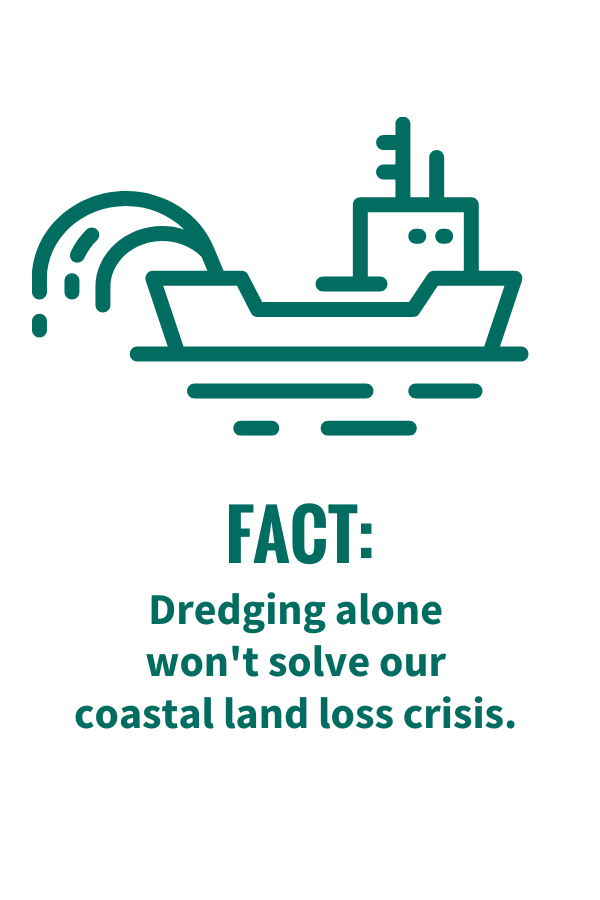Louisiana has lost more than 2,000 square miles of wetlands in less than a century—and the loss continues by the minute. A major cause of this land loss crisis is the leveeing of the Mississippi River, which cuts off the sediment that once built and sustained these wetlands. Reconnecting the Mississippi River to its wetlands, is fundamental to restoring coastal Louisiana;
The Mid-Barataria Sediment Diversion is Louisiana’s most critical restoration project, using the power of the Mississippi River itself to restore Louisiana’s natural land-building processes. It will reconnect the river to adjacent wetlands and restore the natural balance that built south Louisiana in the first place.
While concerns about potential impacts exist, the state is investing hundreds of millions in mitigation to address them.
What is not an option is doing nothing—the cost of inaction is continued land loss, weakened storm protection and increased risk to communities.
Despite broad public support, including in coastal parishes, misinformation about the project has led to confusion. Some opponents have exaggerated concerns while ignoring the reality that no alternative can restore land at the scale and speed needed.
The fact is, Louisiana’s coast is vanishing, and the Mid-Barataria Sediment Diversion is a proven, science-backed solution to help save it.
Setting the Record Straight
Let’s take a look at some of the facts about the project and set the record straight.
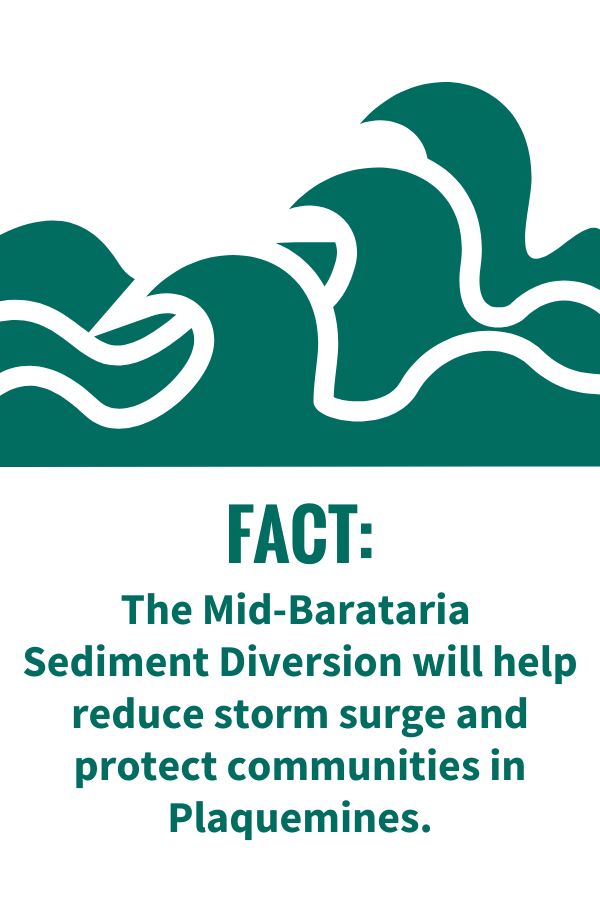
fact: The Mid-Barataria Sediment Diversion will help reduce storm surge and protect communities in Plaquemines Parish.
- Introduces 5.5M tons of sediment/year, creating 5,000 acres of wetlands in 10 years, 17,000 acres in 30 years—helping counter sea level rise.
- Wetlands reduce storm surge by up to 1 foot per 2.7 miles, protecting Plaquemines, Jefferson, and Orleans Parishes.
- Maximum 75,000 cubic feet/sec flow occurs only during high river levels (spring/summer floods); gates close during storms.
- FEMA confirms no flood insurance rate increases for Plaquemines Parish.
- CPRA allocated funds for mitigation (raising homes, roads, piers, improving sewers) to enhance local resilience.

FACT: The Mid-Barataria Sediment Diversion will not worsen saltwater wedges or harm navigation.
- Saltwater wedges form during low river flow (below 400,000 cfs in 2023-24).
- MBSD closes during these events, ensuring safety and navigation.
- A controlled, gated structure allows CPRA to shut it down when needed.
- No navigation risk—its max flow (75,000 cfs) is smaller than natural diversions like Neptune Pass (100,000+ cfs).
- 2022 U.S. Army Corps study: Saltwater wedge speed unchanged from 2012, before Neptune Pass increased flow.
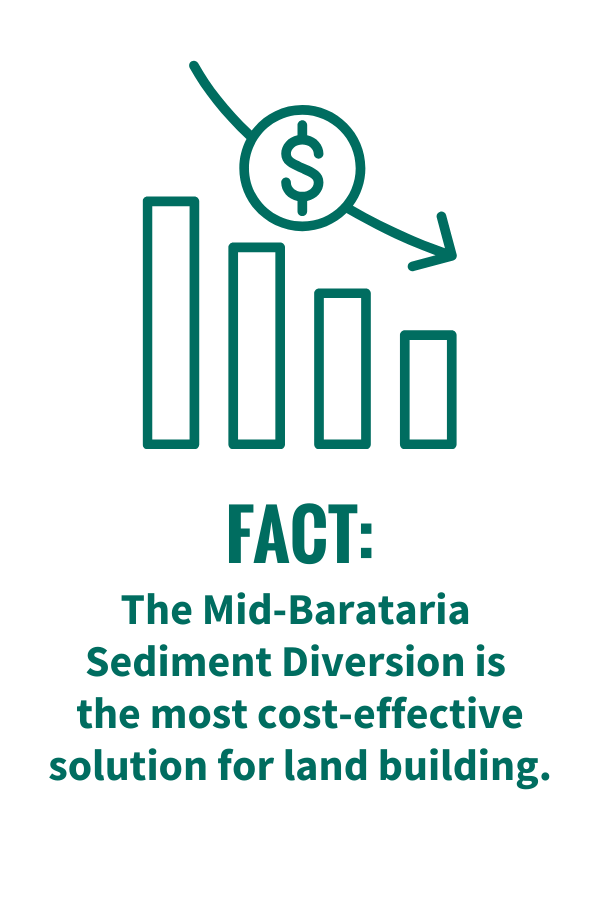
FACT: The Mid-Barataria Sediment Diversion is the most cost-effective solution for land building.
- Dredging equivalent land would cost $6B—twice as much as MBSD.
- The Louisiana Trustee Implementation Group (TIG) funds are legally dedicated to Mid-Barataria, not other projects.
- TIG warned CPRA: Not building as approved could cost Louisiana hundreds of millions.
- Every day of delay costs thousands of dollars; changes to design/capacity would further waste money and time.
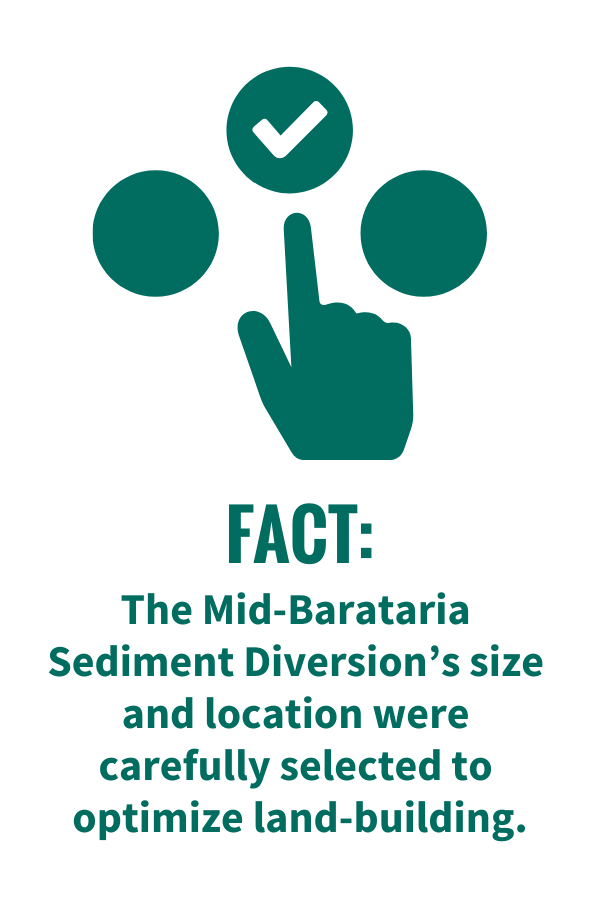
FACT: The Mid-Barataria Sediment Diversion is the most cost-effective solution for land building.
- A diversion was first proposed in Myrtle Grove in 1984.
- Decades of studies show larger diversions capture significantly more sediment.
- A 75,000 cfs diversion captures 9x more sediment than a 15,000 cfs diversion.
- Modeling from the 2012 Coastal Master Plan found multiple small diversions were less effective.
- Without diversions, land-building would be reduced by 300+ square miles.

FACT: The Mid-Barataria Sediment Diversion has strong public support, including throughout coastal parishes.
- A 2023 poll found 80% of Louisianans and 79% of coastal parish residents support sediment diversions.
- In 2024, 80+ Plaquemines Parish residents, including commercial fishermen, backed the diversion in a letter to Gov. Landry.
- CPRA has held 316 meetings with 12,000 stakeholders over 4 years, including elected officials, industry members, and the public.
- Outreach and engagement efforts are ongoing to guide project implementation and mitigation plans.
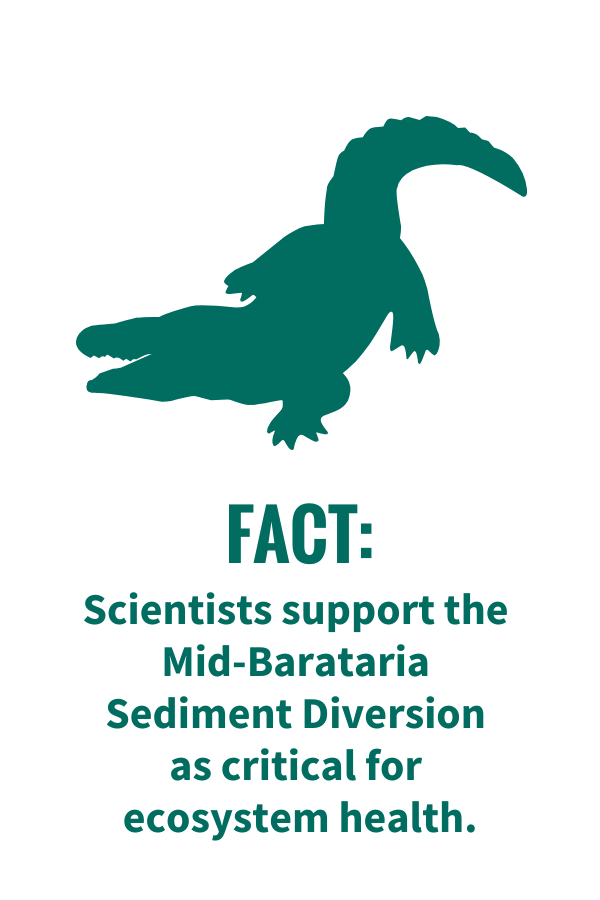
FACT: Scientists support the Mid-Barataria Sediment Diversion as critical for ecosystem health.
- The Army Corps’ Environmental Impact Statement (FEIS) warns that without the diversion, wetlands will continue collapsing, harming fisheries and dolphins.
- Restoring Barataria Basin benefits both local and Gulf ecosystems.
- The state has committed $40 million to monitor and mitigate impacts to dolphins.
- In 2021, 55 scientists with 1,300 years of combined experience endorsed the diversion.
- In 2024, 40 more scientists reaffirmed its importance as a key project in the Coastal Master Plan.
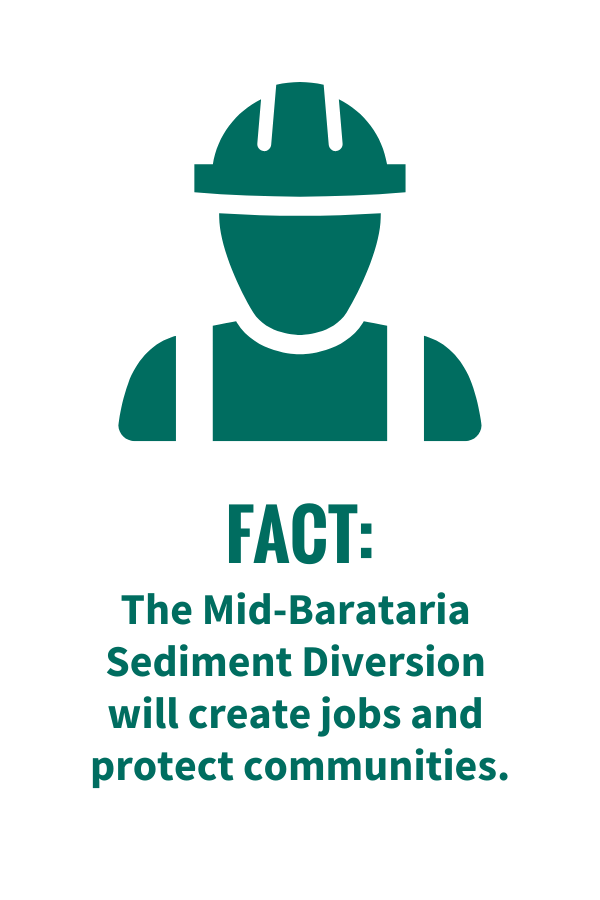
Fact: The Mid-Barataria Sediment Diversion will create jobs and protect communities.
- The project is essential for preserving Plaquemines Parish’s way of life as land loss, stronger storms, and rising seas threaten communities.
- It will restore thousands of acres of wetlands, providing critical storm surge protection.
- A new economic study projects $1.9 billion in new business sales in Plaquemines Parish.
- Construction will generate $65.4 million in local revenue and support an average of 540 jobs annually, peaking at 641 in year three.
- Over five years, residents will see a $308.2 million increase in household earnings.
- Across five parishes (Plaquemines, Orleans, Jefferson, St. Tammany, and St. Bernard), the project will create 3,000+ jobs and increase business sales by $2.8 billion.
Fact: Dredging alone won’t solve our coastal land loss.
- 20 dredging projects planned to restore 15,000 acres, but it’s not enough.
- Dredging doesn’t address subsidence, hurricanes, or sea level rise.
- Sediment diversions are necessary to deliver regular sediment to wetlands.
- Without action, 55% of Plaquemines Parish could disappear in 50 years.
- CPRA’s 2012 Master Plan says sustainable restoration needs sediment diversions.
- Dredging is more expensive and less effective than diversions.
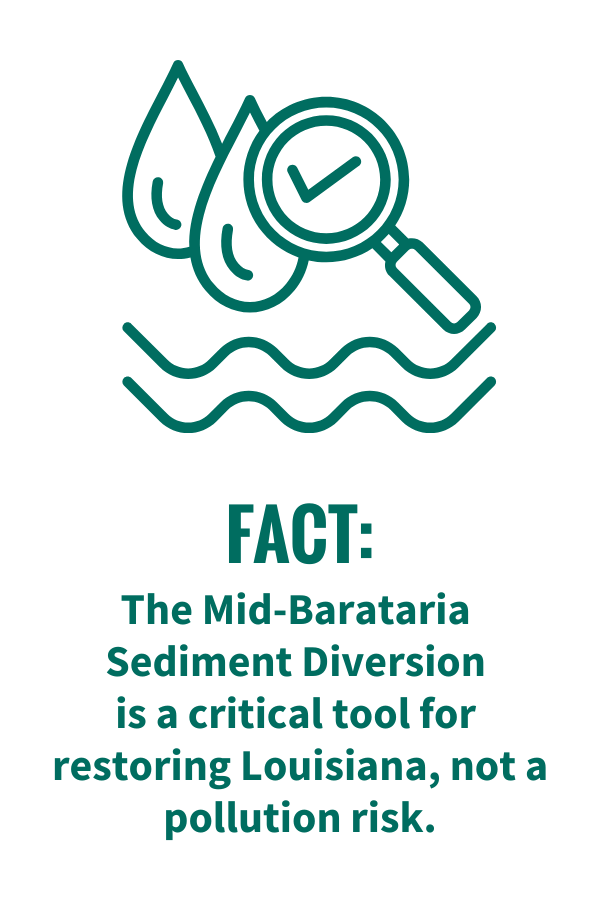
Fact: The Mid-Barataria Sediment Diversion is a critical tool for restoring Louisiana, not a pollution risk.
- The Mississippi River’s water quality has greatly improved over recent decades.
- 2024 EPA assessment shows river water is suitable for aquatic life and recreation.
- The diversion mixes freshwater and saltwater to restore wetlands, supporting coastal ecosystems.
- Claiming the diversion is a “polluted water diversion” misrepresents the project and misleads the public.
- Efforts are underway to continually improve water quality in the river, supported by key environmental organizations.
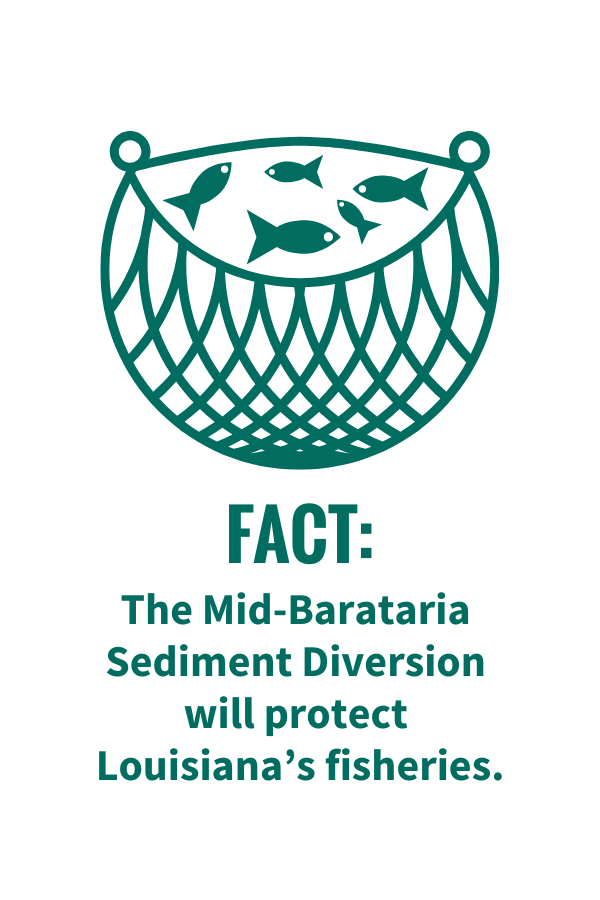
Fact: The Mid-Barataria Sediment Diversion will protect Louisiana’s fisheries.
- The Barataria Basin is collapsing due to wetlands loss.
- The diversion will restore balance and benefit species like shrimp and oysters.
- Millions are being invested in mitigation to help fishers adapt.
- Without the diversion, fishing communities will continue to struggle.
- Areas where sediment is restored show thriving ecosystems and fisheries.
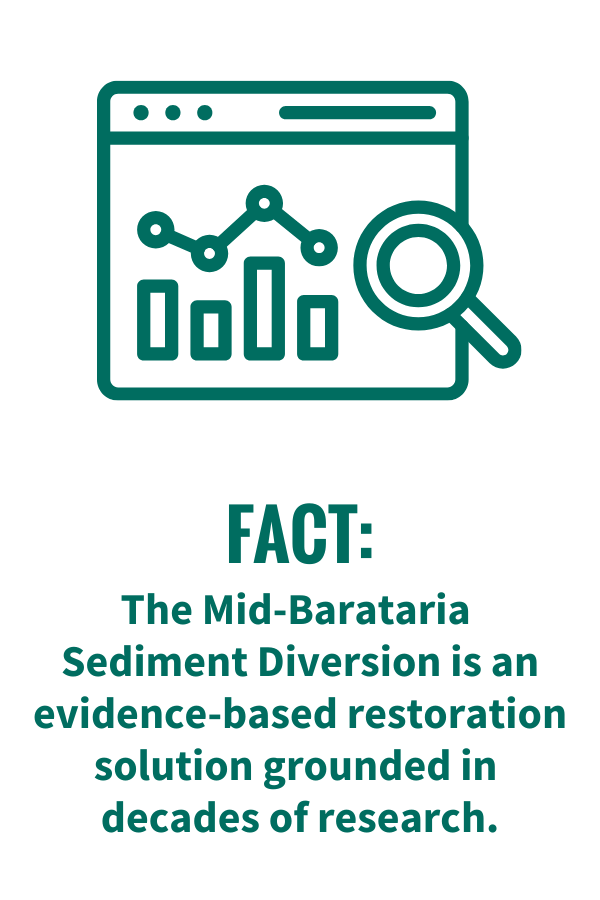
Fact: The Mid-Barataria Sediment Diversion is an evidence-based restoration solution grounded in decades of research.
- The Mississippi River built Louisiana’s wetlands over millennia.
- The Mid-Barataria Sediment Diversion is the most significant restoration project in Louisiana’s history.
- MBSD will restore thousands of acres of wetlands, providing a buffer against storm surge and revitalizing ecosystems.
- A consensus of scientists has recognized reconnecting the river to wetlands as essential for a sustainable future for nearly 50 years.
- The river continues to build land where connected to wetlands, as seen in areas like Plaquemines Parish.
- MBSD is designed to enhance the river’s natural land-building power to combat sea-level rise and subsidence.

Fact: Even with low river flow in 2023, the Mid-Barataria Sediment Diversion would have operated and contributed to land-building by diverting sediment when it mattered most.
- In 2023, low water levels allowed saltwater to threaten water supplies in multiple parishes.
- Despite these low flows, the diversion would have been open for 144 days, contributing sediment during peak river flow.
- Estimates show the diversion will create 5,000 acres of land in 10 years and 17,000 acres in 30 years, even in variable river flow conditions.
- Low river flows also affect other restoration methods, like marsh creation, due to slower recharge of borrow areas in the river.
